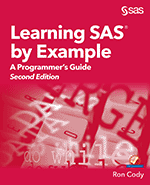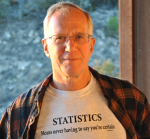I know you all have been anxiously awaiting the arrival of my second edition of Learning SAS® by Example: A Programmer’s Guide (aka The Big Red Book). I can’t believe it has already been 10 years since I first published Learning SAS by Example-everyone loved it so much, we had to do another!
To kick-off the new edition, I wanted to tell you about an exciting new chapter on regular expressions, and the substitution of a chapter on PROC SGPLOT to replace the old SAS Graph chapter.
Want a quick sneak-peak?
Here is an example from the regular expression’s chapter.
Tip: Want to check that your phone numbers are in a standard form? Just run the program below:
Here is the resulting output:

Simple but effective!
You will find (or already know) that cleaning your data takes up around 80% of the total analysis – your analysis is only as good as the quality of your data. As you become more efficient BASE SAS programming you will want to think more about how to clean up that data - here in this video I talk about the latest edition of my data cleaning book.
Meeting and talking to SAS programmers at conferences is one of my favorite things about being a SAS Press author! I love to hear about your experience learning to program with my SAS books, and I can’t wait to discuss how my books have helped you along your SAS programming journey.
What insight did you learn from the first edition of Learning SAS® by Example that you are hoping to see in this new edition?
Check out Learning SAS® by Example, Second Edition and my other books here: SAS Press Books: Ron Cody.


5 Comments
Thank you for being my personal instructor on this subject.
We enjoyed your current article a lot and most of
all enjoyed how you handled the areas I considered to be controversial.
You are always really kind towards readers much like me
and assist me to in my existence. Thank you.
Excellent post.Never knew this, thank you for letting
me know.
Are the programs and datasets used in the second edition the same as those used in the first edition? I cannot find legacy downloads of first edition materials anywhere on the SAS website. I have the first edition, and would like to use the programs associated with it for learning.
I am learning SAS using this book. Many of your programs do not have the code for importing the data sets that are in txt for csv formats, which makes me run the code difficult. For example, I cannot run the program p20.7. Was I wrong? Thanks.
Hi.
You should find a program called Create_Datasets.sas in the download package. If you run that it will create all the data sets (including Stocks) used in the book. If you can't find that program, please email me at ron.cody@gmail.com. Best,
Ron Cody